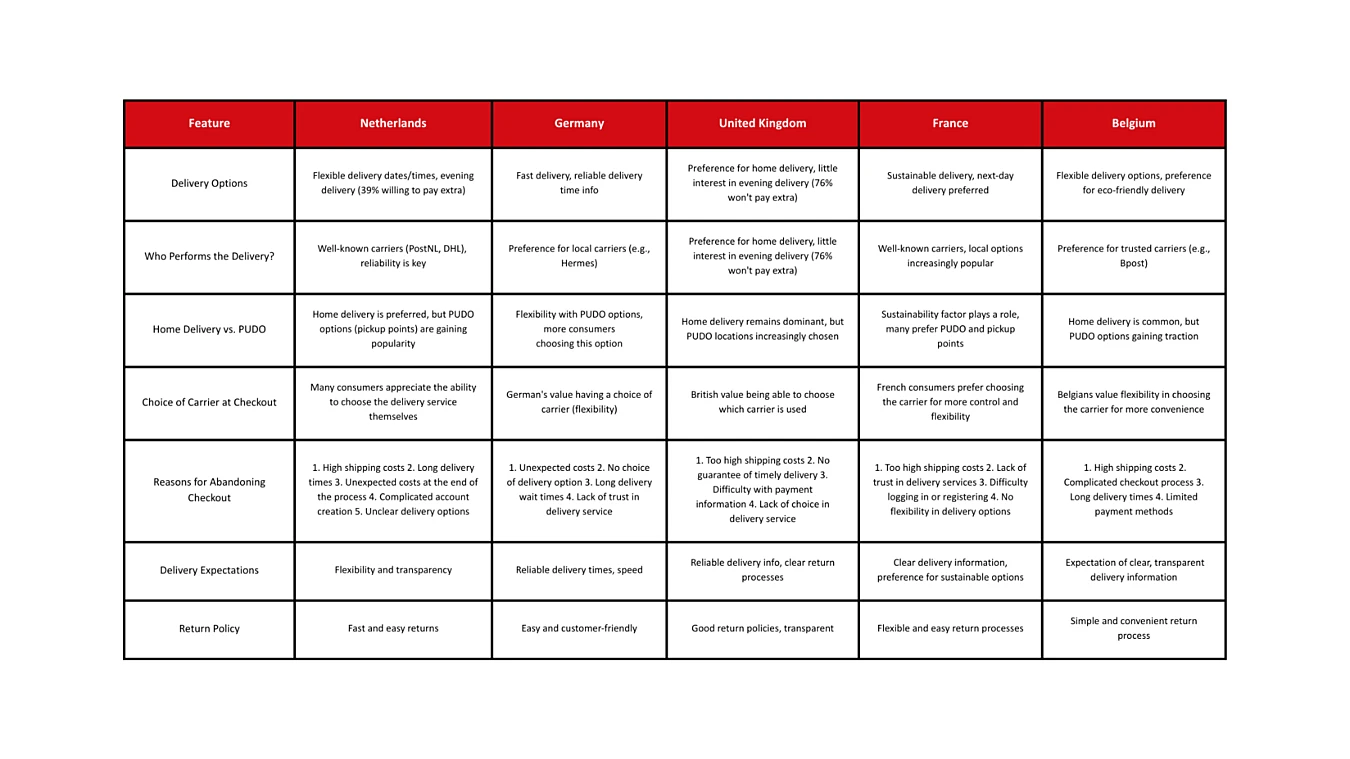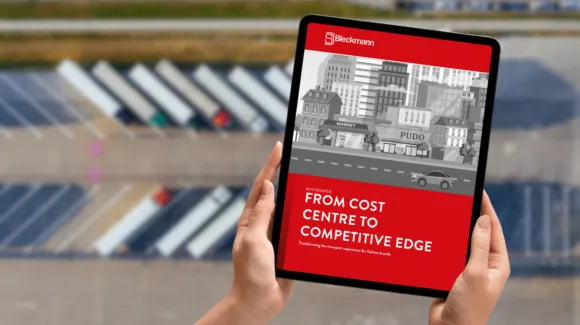“Fast, reliable delivery is no longer sufficient to create a standout transport experience. The e-commerce checkout experience is crucial for turning browsers into buyers.”
As e-commerce continues its rapid expansion and direct customer interactions become increasingly digital, businesses face mounting challenges in cultivating meaningful customer relationships and sustainable loyalty. This paradigm shift increases the significance of every customer touchpoint throughout the purchasing journey. And while fashion brands keep looking for new ways to improve their customers’ online journeys, one crucial piece often gets overlooked: how you communicate about transport.
All too often, transport is still treated as a background function – something that’s important for keeping operations running smoothly, but not something that directly touches the customer experience. The reality is very different. Fast, reliable delivery is no longer sufficient to create a standout transport experience. While ‘fast and flexible delivery options’ are the most important factor for 24% of fashion shoppers in the EU5 countries (France, the UK, Germany, Italy and Spain), there’s something that matters even more: transparency.
In fact, according to proprietary research by Business of Fashion, ‘transparent pricing, duties and delivery updates’ are the most important factor for 28% of EU5 fashion shoppers. This highlights just how crucial the e-commerce checkout experience is for turning browsers into buyers. A poorly designed checkout can put off even your most engaged customers, while a well-executed one can be the difference between someone abandoning their cart and actually completing their purchase.
Overcoming the checkout challenge
If there’s one issue that’s become increasingly problematic for fashion brands, it’s cart abandonment – the widely observed ‘checkout challenge’. A significant cause of this problem is poor communication regarding delivery, such as unclear timelines, unexpected costs or a lack of flexibility. For example, according to Statista, 41% of shoppers abandon their carts because shipping costs are too high. Meanwhile, Sendcloud research reveals that 44% of shoppers in Europe will abandon their order when their preferred shipping option isn’t available. In addition, 18% of customers will abandon their cart if the online checkout process is too long or confusing.
These statistics reveal a clear opportunity: by streamlining your checkout journey and making transport options more visible and better suited to customer preferences, you can directly improve e-commerce conversion rates. According to research, 35% of abandoned online orders in Europe and the US could be recovered simply by improving the checkout experience for customers. That increase in conversion translates to $260 billion worth of recoverable revenue in these regions alone.5 So, while a strong transport infrastructure is essential behind the scenes, its real value is only realised when it’s paired with flexibility, clarity and customer-focused communication at the checkout.
The secrets to avoiding a high cart abandonment rate
1. Cater to regional delivery preferences
Behind every abandoned online shopping cart is a customer whose expectations weren’t met. And one of the leading causes of cart abandonment is a lack of preferred delivery options tailored to regional preferences. In Belgium, for example, customers demonstrate a strong preference for certain carriers, looking specifically for delivery via Bpost. If that option is missing or not clearly visible at checkout, it can create a moment of hesitation that then leads to cart abandonment. Similarly, customers in the UK show a stronger preference for direct home delivery as opposed to out-of-home (OOH) options, which are – conversely – very popular among shoppers in France.
“Between 29% and 41% of customers would be less likely to shop with a brand if no convenient shipping options are available at the checkout.”
These regional variations may seem insignificant, but adapting to such preferences is essential to keep customers engaged. Clearly communicating delivery options and providing customers with a choice of couriers and drop-off locations at checkout can help convince shoppers to complete their purchase at the final stage of the buying journey. Optimising your checkout with the right level of choice and information helps you reduce cart abandonment by letting customers know you understand what they want.

Fashion brands that customise the checkout experience based on regional preferences often see immediate benefits in customer satisfaction and conversion rates. For example, Belgian fashion retailer Espace Mode observed a notable increase in customer satisfaction and repurchase intention after switching to a delivery partner that offered a better network of PUDO points (Bpost), in line with local customer preferences. It enabled the brand to achieve a net promoter score (NPS) of 93 and a delivery experience rating of 98%. Similarly, Danish store chain Flying Tiger Copenhagen was able to increase its online conversion rates by 20% by switching to a provider that offered more convenient delivery options – showcasing the financial benefits of a tailored checkout experience.
“Belgian fashion retailer Espace Mode observed a notable increase in customer satisfaction and repurchase intention after switching to a delivery partner that offered a better network of PUDO points.”
Delivery preferences are shaped not only by consumer habits but also by geographical factors in different markets, such as population density and the proportion of people living in urban versus rural areas. These variables affect how practical and value-adding services like home delivery or PUDO points are likely to be. For instance, customers in rural locations may show a preference for home delivery, while city dwellers may find out-of-home collection hubs more convenient. By optimising the checkout experience to suit the realities of each market, brands can turn what might seem like a minor logistical detail into a strategic advantage – securing sales that might otherwise be lost.
2. Offer the flexibility and optionality customers need
Today’s online shoppers demand a range of shipping options. In fact, between 29% and 41% of customers would be less likely to shop with a brand if no convenient shipping options are available at the checkout. A one-size-fits-all approach to transport can therefore directly impact your brand’s profitability. To remain competitive, fashion and lifestyle brands must ensure that flexibility forms the core of their transport strategy, and tell their customers exactly what delivery options are available upfront at the checkout. Consumers expect to choose not only what they buy, but also how, when and from whom it will be delivered – whether it’s home delivery or collection from lockers, pickup points or in-store hubs. This delivers the optionality customers now expect as standard.
The ‘WWW’ principle
When designing your brand’s checkout experience, it’s important to think about the ‘WWW’ principle: with whom, when, and with which service. Getting each of these elements right gives you a complete picture of what your customers need from their transport experience – and helps you avoid missing out on valuable conversions.
• WITH WHOM: Which carrier or last-mile partner is handling the parcel?
• WHEN: Does the delivery timing match what the customer wants, e.g same-day, next-day, or a specific scheduled time?
• WITH WHICH SERVICE: Does the delivery method suit the customer’s preference, e.g. home delivery, locker pickup, in-store collection?
Get any of these wrong and you create friction that can damage customer loyalty. For example, if you use a carrier whose nearest pickup location is 10 miles from a customer’s home when another provider has one just 200 metres away, you’ve missed a huge opportunity to deliver an excellent and memorable transport experience.
And there’s evidence that more flexibility in delivery options directly translates to better commercial results. According to a study by delivery experience platform Ingrid, incorporating more carriers into the checkout process can boost conversion rates by 5.8%, while offering a broader range of delivery options can lead to a 27.7% increase in conversions. This data shows just how much providing diverse delivery choices to meet varying customer preferences can impact your bottom line.
However, the checkout is only half the story. Post-sale transparency during fulfilment is equally critical. Predictive analytics and milestone tracking allow brands to stay ahead of customer expectations. When delays happen, customers are far less frustrated if they know what’s going on and when they can expect their items to arrive. Keeping customers informed after they’ve made a purchase shows you value their entire experience, not just the sale itself. This kind of care builds trust and lays the foundation for long-term loyalty.
3. Prioritise transparency around returns policies
One of the most overlooked contributors to cart abandonment is a lack of clarity around the returns process. Shoppers hesitate to complete an online purchase when the return policy is unclear – making this one of the top concerns preventing conversion at the final step. For example, research by McKinsey shows that 65% of shoppers are likely to abandon a shopping cart if the returns policy is ‘inflexible’.13 In addition, 33% of repeat customers would abandon a retailer following a ‘difficult’ returns experience.14 Customers need to know that if a product doesn’t meet expectations, returning it won’t be complex or costly. By clearly communicating your return policy at checkout, brands can remove a major barrier to purchase, giving customers the confidence to click ‘buy’.
The online shopping experience, especially in fashion and lifestyle retail, is complicated by the fact that consumers are buying items they cannot try on or physically inspect. That uncertainty makes a no-hassle returns process even more important. When your policy is hard to find or filled with confusing jargon, it signals to customers that returning products might be a struggle. On the other hand, a transparent and easily accessible returns promise signals confidence in your product and fairness in your service, giving shoppers the peace of mind they need.
This shows how returns have evolved from a post-purchase consideration to a key factor in the pre-purchase decision-making process. Shoppers are essentially doing their own mini risk assessment at checkout, weighing up how much friction they might encounter if the product doesn't meet their expectations. Brands that fail to provide clear, convenient return options inadvertently signal a potential problem that many customers simply aren’t willing to risk.
Offering clear returns information at checkout also reduces post-purchase confusion and the burden on customer service teams. If customers don’t understand how to return an item, they often turn to call centres or help desks, which creates inefficiencies for your operations and frustration for customers. Integrating key information – such as whether returns are free and whether drop-off points are available – directly into the checkout interface helps manage expectations. It also builds customer trust from the start by providing the safety net of a clear returns policy and process if needed.
Optimising the checkout experience to secure customer loyalty
“As physical retail declines and more brand interactions take place digitally, delivery becomes one of the few remaining tangible, physical customer experiences.”
Transport has long been considered a back-end function – simply a way of moving goods from A to B. But as physical retail declines and more brand interactions move online, delivery is becoming one of the few remaining tangible, physical touchpoints with customers. Therefore, every decision you make about how transport is communicated, priced and delivered has the power to shape brand perception and influence customer loyalty.
In fact, the e-commerce checkout has become one of the most critical pressure points in fashion retail today – the moment where shopping carts either convert into revenue or are lost to abandonment. Solving this ‘checkout challenge’ requires a fundamental shift in how transport is understood and utilised throughout the customer journey.
This means transport can no longer sit outside of your core strategy for customer acquisition and retention. Instead, it needs to be integrated into your broader business model as a value-adding function. By building flexibility, transparency and regional relevance into your transport solutions – and presenting these clearly at checkout – brands can directly reduce cart abandonment and boost conversion rates.










